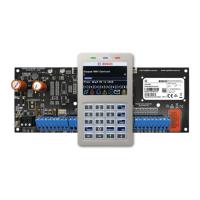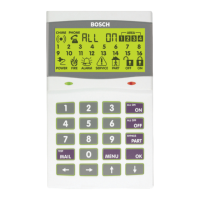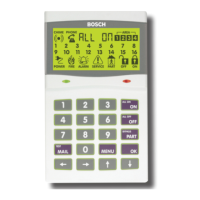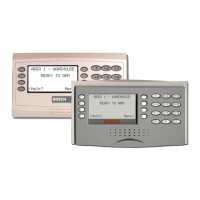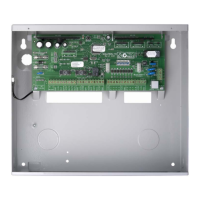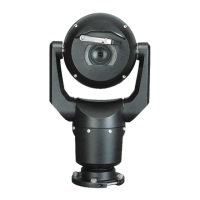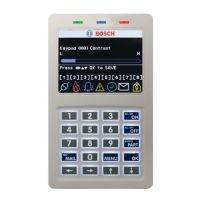
Do you have a question about the Bosch Solution 6000-IP and is the answer not in the manual?
| Event Log | Yes |
|---|---|
| Areas | 1 |
| Partitions | 1 |
| Outputs | 2 |
| Communication | IP, GSM |
| Mobile App | Yes |
| Automation | Yes |
| System Type | Hybrid |
| Battery Backup | Yes |
| Keypads | Up to 8 |
Details copyright, trademarks, liability disclaimers, and owner notices.
Lists crucial safety precautions for installation and operation.
Manage users, PINs, tokens, and RF keyfobs.
Setup and control of system areas, zones, and timers.
Configure sensors, outputs, keypads, and modules.
Time, events, reporting, and system testing options.
Explains the system's purpose, components, and operation.
Lists the main capabilities and specifications of the control panel.
Defines zones, faulted zones, zone types, and system areas.
Details the purpose of each button on the keypad.
Explains how to trigger panic, fire, or medical alarms.
Explains the meaning of various icons and LEDs on the keypad.
Describes the different sounds and alerts the keypad provides.
How to arm the entire system or a specific area.
How to arm only specific zones within an area.
Procedure for disarming the system after an entry delay.
Steps to silence an alarm and clear event memory.
How the system can automatically arm and extend arming time.
Guide to entering text and characters via the keypad.
How to trigger a duress alarm for security.
How to enter programming mode for system setup.
How to remove user data like PIN, token, and name.
Procedure for changing your personal PIN.
How a master user can change another user's PIN.
Steps for a master user to add a PIN for a new user.
How to remove a user's PIN from the system.
How to add, delete, and manage token cards for access.
Procedure to remove a token from a user's profile.
How to identify programmed tokens and their assignments.
How to modify existing token details.
How to program and remove RF keyfob IDs.
How to enter and delete RF Keyfob IDs for users.
How to program names for users, up to 20 characters.
How to grant or restrict user access to specific areas.
Setting or changing various user-specific system options.
Modifying user-specific settings like Master User or Arm Only.
Linking users to timezones for access control.
Controlling user access to door strike or gate outputs.
Assigning future expiry dates for user credentials.
Steps to enroll fingerprints for user access.
How to remove a user's enrolled fingerprint.
Verifying which user is assigned to a programmed fingerprint.
Checking the current armed/disarmed status of system areas.
How to arm or disarm individual system areas.
Arming all assigned areas simultaneously.
Disarming all assigned areas simultaneously.
Navigating the keypad to operate different partitioned areas.
Enabling or disabling chime notifications for zones.
Setting how chime alerts behave when zones are triggered.
Programming custom names for each area (up to 20 chars).
Setting descriptive names for Area Part Mode 1.
Setting descriptive names for Area Part Mode 2.
Completing the naming process for Part Mode 2.
Setting timezones for automatic system arming.
Modifying the time allowed to leave after arming.
Setting the delay for disarming after triggering an entry zone.
Setting a second delay for disarming after zone triggers.
Configuring delay for Part On/Part 2 On modes.
Finalizing Part Entry Time settings.
Checking if zones are Normal, Open, Shorted, or in Alarm.
Displaying zone information in groups of sixteen.
Disabling zones temporarily before arming.
Toggling zone bypass status for arming.
Programming zones to trigger chime alerts when open.
Configuring zones to be monitored in Part 2 On mode.
Enabling/disabling zones for Part 2 On monitoring.
How to reset smoke detectors after an event.
Testing all zones in an area simultaneously.
Testing individual zones via walk test.
Checking the current state of system outputs.
Manually controlling system outputs like sirens or lights.
Finalizing output control actions.
Displaying output status in groups of sixteen.
Checking the current state (Locked, Unlocked, Open) of doors.
Displaying door status in groups of sixteen.
Manually locking or unlocking doors.
Programming descriptive names for outputs.
Programming descriptive names for doors.
Performing a test of the system's external sirens.
Performing a test of the system's internal sirens.
Performing a test of the system's strobe lights.
Performing a test of the system's fire sirens.
Finalizing fire siren test.
Entering customer registration for MyAlarm features.
Manually sending a test report to the monitoring station.
Viewing voltage, temperature, and info for connected modules.
Setting the LCD display contrast for each keypad.
Setting the volume level for keypad buzzers.
Setting the brightness of the keypad's LCD backlight.
Programming descriptive names for keypads and readers.
Setting up Wi-Fi connectivity for keypads.
Interpreting system trouble events and their causes.
Checking system version, temperature, voltage, and troubles.
Displaying panel information and firmware version.
Reviewing current system and non-system trouble conditions.
Explains various trouble conditions and their meanings.
Reviewing the last 2000 recorded system events.
Interpreting the 'Dest' field for reporting destinations.
Checking the true/false status of all 16 timezones.
Programming and adjusting the panel's date and time.
Setting the volume for arm/disarm beeps via radio keyfob.
Programming descriptive names for timezones.
Setting the active periods for each timezone.
Selecting specific days of the week for timezone operation.
Selecting various options like 'Invert Period Logic'.
Entering names for up to 8 programmed holidays.
Programming the dates for holiday periods.
Setting temperature monitoring thresholds for keypads.
Programming a custom name for the entire system.
Testing all zones in an area simultaneously.
Completing the walk test for all zones.
Manually testing the system's backup battery.
